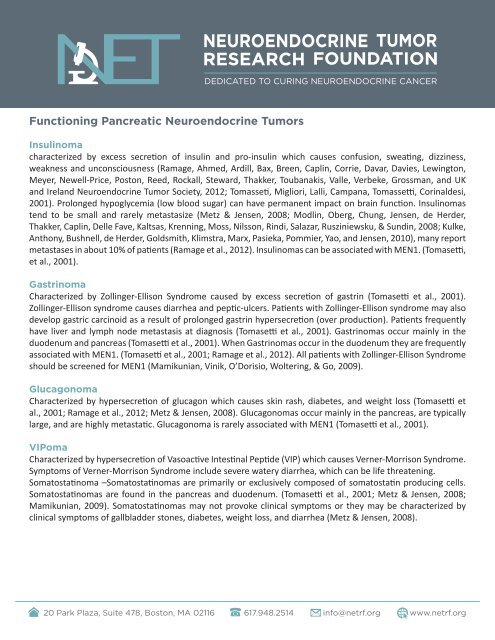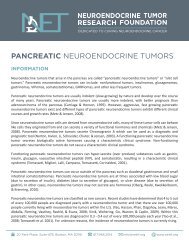PANCREATIC NEUROENDOCRINE TUMORS
You also want an ePaper? Increase the reach of your titles
YUMPU automatically turns print PDFs into web optimized ePapers that Google loves.
Functioning Pancreatic Neuroendocrine Tumors<br />
Insulinoma<br />
characterized by excess secretion of insulin and pro-insulin which causes confusion, sweating, dizziness,<br />
weakness and unconsciousness (Ramage, Ahmed, Ardill, Bax, Breen, Caplin, Corrie, Davar, Davies, Lewington,<br />
Meyer, Newell-Price, Poston, Reed, Rockall, Steward, Thakker, Toubanakis, Valle, Verbeke, Grossman, and UK<br />
and Ireland Neuroendocrine Tumor Society, 2012; Tomasseti, Migliori, Lalli, Campana, Tomassetti, Corinaldesi,<br />
2001). Prolonged hypoglycemia (low blood sugar) can have permanent impact on brain function. Insulinomas<br />
tend to be small and rarely metastasize (Metz & Jensen, 2008; Modlin, Oberg, Chung, Jensen, de Herder,<br />
Thakker, Caplin, Delle Fave, Kaltsas, Krenning, Moss, Nilsson, Rindi, Salazar, Rusziniewsku, & Sundin, 2008; Kulke,<br />
Anthony, Bushnell, de Herder, Goldsmith, Klimstra, Marx, Pasieka, Pommier, Yao, and Jensen, 2010), many report<br />
metastases in about 10% of patients (Ramage et al., 2012). Insulinomas can be associated with MEN1. (Tomasetti,<br />
et al., 2001).<br />
Gastrinoma<br />
Characterized by Zollinger-Ellison Syndrome caused by excess secretion of gastrin (Tomasetti et al., 2001).<br />
Zollinger-Ellison syndrome causes diarrhea and peptic-ulcers. Patients with Zollinger-Ellison syndrome may also<br />
develop gastric carcinoid as a result of prolonged gastrin hypersecretion (over production). Patients frequently<br />
have liver and lymph node metastasis at diagnosis (Tomasetti et al., 2001). Gastrinomas occur mainly in the<br />
duodenum and pancreas (Tomasetti et al., 2001). When Gastrinomas occur in the duodenum they are frequently<br />
associated with MEN1. (Tomasetti et al., 2001; Ramage et al., 2012). All patients with Zollinger-Ellison Syndrome<br />
should be screened for MEN1 (Mamikunian, Vinik, O’Dorisio, Woltering, & Go, 2009).<br />
Glucagonoma<br />
Characterized by hypersecretion of glucagon which causes skin rash, diabetes, and weight loss (Tomasetti et<br />
al., 2001; Ramage et al., 2012; Metz & Jensen, 2008). Glucagonomas occur mainly in the pancreas, are typically<br />
large, and are highly metastatic. Glucagonoma is rarely associated with MEN1 (Tomasetti et al., 2001).<br />
VIPoma<br />
Characterized by hypersecretion of Vasoactive Intestinal Peptide (VIP) which causes Verner-Morrison Syndrome.<br />
Symptoms of Verner-Morrison Syndrome include severe watery diarrhea, which can be life threatening.<br />
Somatostatinoma –Somatostatinomas are primarily or exclusively composed of somatostatin producing cells.<br />
Somatostatinomas are found in the pancreas and duodenum. (Tomasetti et al., 2001; Metz & Jensen, 2008;<br />
Mamikunian, 2009). Somatostatinomas may not provoke clinical symptoms or they may be characterized by<br />
clinical symptoms of gallbladder stones, diabetes, weight loss, and diarrhea (Metz & Jensen, 2008).<br />
20 Park Plaza, Suite 478, Boston, MA 02116 617.948.2514 info@netrf.org www.netrf.org
















